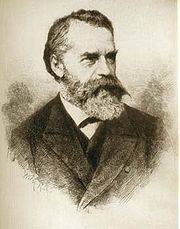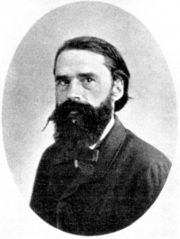
Ferdinand Gregorovius
Encyclopedia


Germany
Germany , officially the Federal Republic of Germany , is a federal parliamentary republic in Europe. The country consists of 16 states while the capital and largest city is Berlin. Germany covers an area of 357,021 km2 and has a largely temperate seasonal climate...
historian
Historian
A historian is a person who studies and writes about the past and is regarded as an authority on it. Historians are concerned with the continuous, methodical narrative and research of past events as relating to the human race; as well as the study of all history in time. If the individual is...
who specialized in the medieval history of Rome
Rome
Rome is the capital of Italy and the country's largest and most populated city and comune, with over 2.7 million residents in . The city is located in the central-western portion of the Italian Peninsula, on the Tiber River within the Lazio region of Italy.Rome's history spans two and a half...
. He is best known for Wanderjahre in Italien, his account of the walks he took through Italy in the 1850s, and the monumental Die Geschichte der Stadt Rom im Mittelalter (History of Rome in the Middle Ages), a classic for Medieval and early Renaissance history. He also wrote biographies of Pope Alexander VI
Pope Alexander VI
Pope Alexander VI , born Roderic Llançol i Borja was Pope from 1492 until his death on 18 August 1503. He is one of the most controversial of the Renaissance popes, and his Italianized surname—Borgia—became a byword for the debased standards of the Papacy of that era, most notoriously the Banquet...
and Lucrezia Borgia
Lucrezia Borgia
Lucrezia Borgia [luˈkrɛtsia ˈbɔrʤa] was the illegitimate daughter of Rodrigo Borgia, the powerful Renaissance Valencian who later became Pope Alexander VI, and Vannozza dei Cattanei. Her brothers included Cesare Borgia, Giovanni Borgia, and Gioffre Borgia...
, as well as works on Byzantine history and medieval Athens
Athens
Athens , is the capital and largest city of Greece. Athens dominates the Attica region and is one of the world's oldest cities, as its recorded history spans around 3,400 years. Classical Athens was a powerful city-state...
, and translated Italian authors into German, among them Giovanni Melis. According to Jesuit Father John Hardon, S.J.
John Hardon
John A. S. A. Hardon, S.J., Servant of God was a Jesuit priest, writer, and theologian. He is the founder of The Holy Trinity Apostolate.-Early life:...
Gregorovius was "a bitter enemy of the popes."
Gregorovius was born at Neidenburg (Nidzica)
Nidzica
Nidzica is a town in the Warmian-Masurian Voivodeship in Poland, between Olsztyn and Mława. It has a population of 14,798 . It is the capital of Nidzica County.-History:...
, East Prussia
Province of East Prussia
The Province of East Prussia was a province of Prussia from 1773–1829 and 1878-1945. Composed of the historical region East Prussia, the province's capital was Königsberg ....
, and studied theology and philosophy at the University of Königsberg
University of Königsberg
The University of Königsberg was the university of Königsberg in East Prussia. It was founded in 1544 as second Protestant academy by Duke Albert of Prussia, and was commonly known as the Albertina....
. In 1838 he joined the Corps Masovia
Corps Masovia Königsberg (Potsdam)
The Corps Masovia is the only remaining academic student corps from the Albertus University in Königsberg. In 2001 Masovia was re-established in Potsdam.-History:The corps name refers to Mazovia, the southern part of the former Prussian province East Prussia...
. After teaching for many years, Gregorovius took up residence in Italy
Italy
Italy , officially the Italian Republic languages]] under the European Charter for Regional or Minority Languages. In each of these, Italy's official name is as follows:;;;;;;;;), is a unitary parliamentary republic in South-Central Europe. To the north it borders France, Switzerland, Austria and...
in 1852, remaining in that country for over twenty years. In 1876 he was made honorary citizen of Rome, the first German to be awarded this honor. A street and a square is named after him. He eventually returned to Germany, where he died in Munich
Munich
Munich The city's motto is "" . Before 2006, it was "Weltstadt mit Herz" . Its native name, , is derived from the Old High German Munichen, meaning "by the monks' place". The city's name derives from the monks of the Benedictine order who founded the city; hence the monk depicted on the city's coat...
.
Works
- Der Ghetto und die Juden in Rom, Mit Einem Geleitwort von Leo Baeck, Im Schocken Verlag/Berlin, 1935 (originally published, 1853)
- Der Tod des Tiberius ("TiberiusTiberiusTiberius , was Roman Emperor from 14 AD to 37 AD. Tiberius was by birth a Claudian, son of Tiberius Claudius Nero and Livia Drusilla. His mother divorced Nero and married Augustus in 39 BC, making him a step-son of Octavian...
' Death", 1851) - Geschichte des römischen Kaisers Hadrian und seiner Zeit ("History of the Roman Emperor HadrianHadrianHadrian , was Roman Emperor from 117 to 138. He is best known for building Hadrian's Wall, which marked the northern limit of Roman Britain. In Rome, he re-built the Pantheon and constructed the Temple of Venus and Roma. In addition to being emperor, Hadrian was a humanist and was philhellene in...
and His Times", 1851) - Corsica (1854)
- Göthe’s Wilhelm Meister in seinen socialistischen Elementen entwickelt. Schwäbisch Hall: E. Fischhaber, 1855.
- Geschichte der Stadt Rom im Mittelalter (1859–1872) Translated into English 'The History of Rome in the Middle Ages' (1894–1902). (reissued by Italica Press, 2000–2004.); (reissued by Cambridge University PressCambridge University PressCambridge University Press is the publishing business of the University of Cambridge. Granted letters patent by Henry VIII in 1534, it is the world's oldest publishing house, and the second largest university press in the world...
, 2010. ISBN 9781108015134) - Wanderjahre in Italien (1856–1877)
- Geschichte der Stadt Athen im Mittelalter. Von der Zeit Justinians bis zur türkischen Eroberung ("History of Athens in the Middle Ages. From Justinian to the Turkish Conquest", 1889)
- Lucrezia Borgia (1874)
- Die Grabmäler der Römischen Päpste (The Tombs of The Roman Popes), first edition 1857 in German (Google books link), later in 1881 as Die Grabdenkmäler der Päpste (The Tombs of The Popes) (Open Library link) and in English as The Tombs of the Popes (tr: Louisa W. Terry) Victoria Press, Rome 1904 (Google books link)

